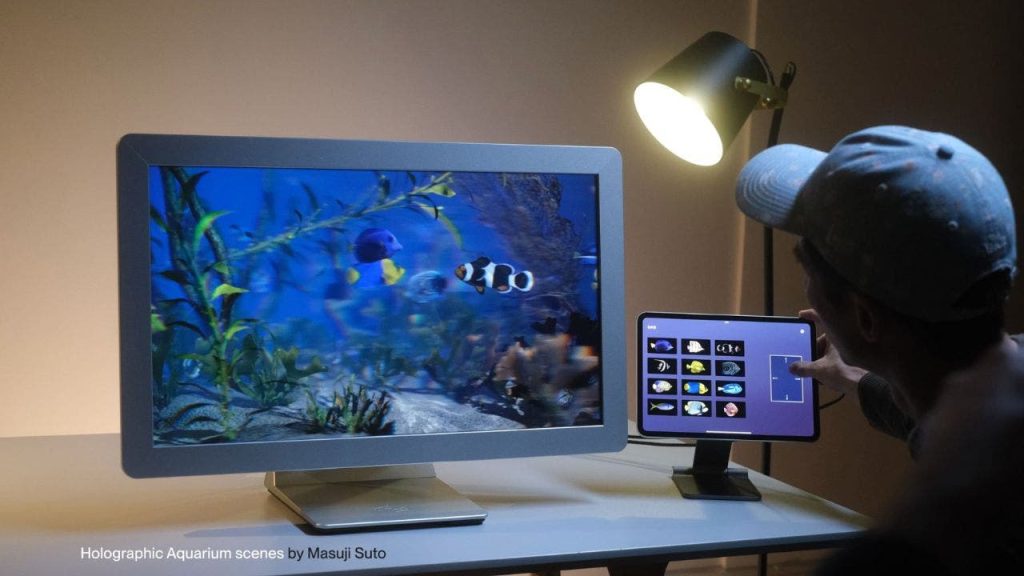A revolutionary advancement in immersive technology has emerged with the launch of the 27-inch light-field display by Looking Glass. This innovative device allows users to see digital 3D content with a level of realism that does not require headsets or glasses, creating an engaging shared experience. The advancement aims to enhance applications in education, design, and entertainment by providing unparalleled depth and perspective viewing for groups.
| Article Subheadings |
|---|
| 1) How the Technology Functions |
| 2) A Major Shift in Collaborative Experiences |
| 3) Streamlining 3D Creation and Deployment |
| 4) Real-World Applications of the Display |
| 5) Summary of Key Implications |
How the Technology Functions
The Looking Glass 27 employs cutting-edge light-field technology to project multiple perspectives of an object simultaneously. This allows for what is referred to as “Super Multi View” experiences, where viewers can see different angles just as they would in real life. Traditional 3D displays often fall short in providing true depth perception, whereas this display offers richer depth cues, transforming how we experience visual content.
Developed by the tech firm Looking Glass, the display can showcase a range of content, from simple images to complex 3D videos and interactive applications. Its versatility enables uses in diverse settings, from quick model previews to fully interactive group experiences. This dynamic functionality marks a significant evolution in the realm of 3D visualization, as it brings immersive technology into a more accessible realm for both businesses and consumers.
A Major Shift in Collaborative Experiences
According to Shawn Frayne, CEO and co-founder of Looking Glass, the new 27-inch display represents a pivotal moment for 3D technology. It’s not just about visual quality; it creates opportunities for collaborative experiences that have been elusive in traditional media. Each user around the display can appreciate distinct perspectives of a digital object without needing separate headsets, allowing teams and groups to engage with content in a more meaningful way.
The physical attributes of the display bolster its innovative capabilities. Slim and lightweight at just one inch thick, it features an impressive resolution of 5,120 x 2,880 pixels at 60 Hz and provides up to 16 inches of virtual depth. This combination makes for real-time visuals that feel genuinely present, enhancing the tactile experience of 3D engagement. Moreover, the display can accommodate up to 100 unique viewpoints within a 53-degree cone, pushing the boundaries of shared visual experiences.
Streamlining 3D Creation and Deployment
The Looking Glass 27 has opened avenues for developers with its streamlined pipeline for creating, testing, and deploying 3D applications. Content creation starts on a computer using Unity software, with the finished products deployable on an iPad, which also controls the display. This configuration reduces costs significantly—by approximately 35%—making advanced technology more accessible.
Flexibility is a hallmark of this display. It can be set on a desk or mounted on a wall, depending on user preference, and is available in both portrait and landscape configurations. The accompanying software ecosystem facilitates the rapid development of 3D applications through Unity templates while allowing consistent management akin to any iOS application, enabling straightforward updates and deployment.
Real-World Applications of the Display
Though the price point—marked at $10,000, or $8,000 for pre-orders—positions the Looking Glass 27 as a costly asset for ordinary consumers, its intended audience is distinctly defined. Various sectors, including businesses, educational institutions, museums, and medical training centers, stand to benefit from this state-of-the-art technology. For instance, medical students can delve into virtual anatomy lessons collaboratively, while design teams can evaluate 3D prototypes without the encumbrance of headsets.
The device’s ability to depict depth, texture, translucency, and lighting effects as they appear in real life underscores its potential as a valuable resource across fields that require visualization of complex spatial information. The implications extend beyond mere entertainment; this technology harbors the promise of revolutionizing methods of learning, teaching, and collaboration in multiple professional domains.
Summary of Key Implications
The launch of the Looking Glass 27-inch light-field display signifies a fundamental shift in how we perceive and interact with three-dimensional content. By allowing shared experiences without headsets, it emphasizes collaboration and the collective appreciation of digital innovations. Although still priced for an enterprise market, its advancements herald a future where immersive, headset-free 3D can become integral to various industries, positioning it as a substantial tool for creativity and collaboration.
| No. | Key Points |
|---|---|
| 1 | The Looking Glass 27 allows for shared 3D experiences without the need for headsets. |
| 2 | Utilizes cutting-edge light-field technology for enhanced depth perception. |
| 3 | Significantly reduced costs and flexibly creates 3D applications. |
| 4 | Targets industries such as education, healthcare, and design for collaborative applications. |
| 5 | Promotes new ways of learning, teaching, and collaboration in various domains. |
Summary
The introduction of the Looking Glass 27 represents a landmark achievement in the realm of 3D visualization technologies. Its capacity for fostering group interactions in a headset-free environment marks a transformative step towards accessibility and engagement in the digital space. While it currently serves a specialized market, its implications for future uses are vast and promising, suggesting a new era of immersive technology that could redefine collaboration and creativity across various professional landscapes.
Frequently Asked Questions
Question: How does the Looking Glass 27 improve 3D visualization?
The Looking Glass 27 utilizes light-field technology, allowing users to see different perspectives of 3D objects simultaneously, enhancing depth perception and realism without the need for headsets.
Question: Who are the primary users of the Looking Glass 27 display?
The primary users include businesses, educational institutions, medical training facilities, and creative design teams that benefit from collaborative and immersive visual experiences.
Question: What programming interfaces can be used with the display?
The Looking Glass 27 supports major software platforms like Unity, Blender, and Unreal Engine, facilitating a streamlined workflow for developers and creating diverse 3D applications.
